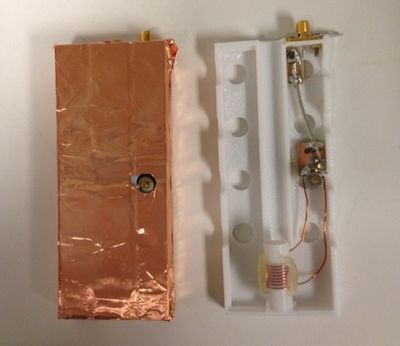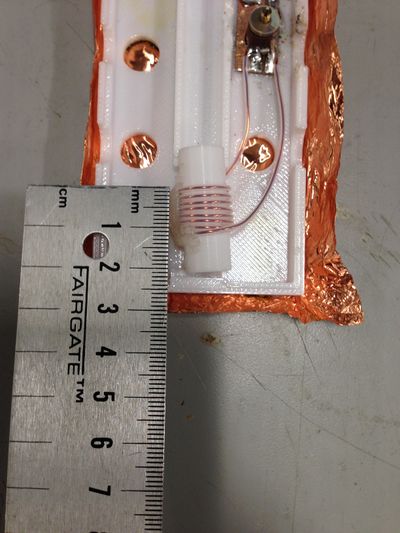Hardware:RF
RF Coil
The RF coil for this system is used for transmitting the excitation pulse to get the magnetization precessing and to detect the MRI signal thru the Faraday detection principle. The coil is part of a resonant circuit that is tuned to the Larmor frequency of the B0 magnet. The coil is a solenoid which the NMR tubes fit into snuggly; it is contained in a plastic case which is wrapped in copper foil to shield against external RF noise sources.
TR Switch
The RF coil is used for 2 things: transmitting the RF pulse and receiving the MRI signal. This means that it should sometimes be connected to the transmit amplifier and sometimes be connected to the receive amplifier. This TR switch uses pin diodes and a lumped quarterwave line to effectively switch the coil connection between the two amplifiers, as shown in this schematic diagram.
Receive amplifier
The NMR signal from the coil is very small, so a a pre-amplifier with a low noise figure is needed as the receive amplifier. A 2 stage amplifier was designed using Gali-74+ Monolithic Amplifier from Minicircuits. The TR switch and pre-amplifier circuit were combined in a single PCB. Click here to download the Eagle board files for the TR Switch PCB.
Power amplifier
The RF pulse created by the Medusa console is amplified by a 1,2W broadband RF power amplifier (MiniCircuits ZHL-3A). Because we had some trouble with the carrier frequency coming through the transmit side even when the pulse was "off" at the console, we found we needed to gate the power to the ZHL-3A using the gating pulse from the console so that the ZHL-3A only receives power during the RF pulse. This also prevents the ZHL-3A from dissipating heat between RF pulses.

